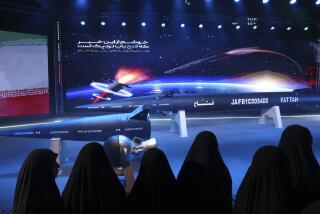Hughes Rolls Out Advanced Missile : Military Lavish in Praise of Costly AMRAAM System
- Share via
TUCSON — After a difficult and costly development effort that thrust the company into controversy, Hughes Aircraft unveiled Wednesday the first production model of its advanced medium-range, air-to-air missile.
The missile, known as AMRAAM, is the first of 24,000 that will be built by Hughes and its competitor, Raytheon, by the year 2000 at a total cost of $7.58 billion. Foreign sales and licensing agreements will bring the companies additional business.
Hughes began development of the missile in 1981 under a fixed-price Air Force contract with a 70-month schedule that came to be considered unrealistically short. The schedule eventually had to be extended for 25 months, forcing the firm to spend $255 million of its own funds. In the aerospace industry, that situation highlighted what has been regarded as the unreasonable risk of conducting advanced research under fixed-price contracts.
Although the AMRAAM program suffered problems, the performance of the missile in tests conducted during the past two years has largely silenced critics. Air Force officials said Wednesday that the missile will provide a huge leap in capability over existing missiles.
“This is one of the finest achievements in the history of this company,” said Hughes Chairman Malcolm Currie. “This missile is what the company is all about. This is what we dream about.”
Replacing Sparrow Missile
The Air Force, which has been an uncompromising customer, was lavish in its praise Wednesday. Four Air Force generals attended the ceremony at the Hughes missile production facility in Tucson. The Navy, Air Force and Marine Corps flew in their newest jet fighters from across the country to display at the ceremony. A local Army band performed as well.
Air Force officials have said that AMRAAM will double the combat capability of the F-15 fighter and increase the effectiveness of the F-16 by sixfold. The missile is intended to be used at ranges of more than 30 miles, depending on whether the target is approaching or moving away.
AMRAAM will replace the Sparrow missile, widely considered an ineffective weapon. AMRAAM was successful in 78% of its test shots in recent years.
Even longtime AMRAAM critic Thomas Amlie, former technical director of the China Lake Naval Weapons Center, this week praised AMRAAM as a “brilliant technical achievement,” though he said it is far too expensive. Congressional critics have raised concerns about the affordability of the system.
Air Force Brig. Gen. Kenneth E. Franklin, director of the AMRAAM program, said the missile will cost about $300,000 each in 1984 dollars, but Amlie said he believes that the missile will eventually cost $500,000 each.
More to Read
Inside the business of entertainment
The Wide Shot brings you news, analysis and insights on everything from streaming wars to production — and what it all means for the future.
You may occasionally receive promotional content from the Los Angeles Times.











